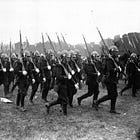The Army of Africa (Armée d’Afrique) served both as a garrison for French possessions and protectorates in North Africa and a source of reinforcements for the French armies in the event of a European war. At the start of 1914, 38 of the 73 infantry battalions of the Army of Africa were units of Algerian sharpshooters (tirailleurs algériens), the rank-and-file of which were exclusively recruited from the Muslim communities of French North Africa. Of the remaining units, 25 were zouave battalions, 5 were battalions of African light infantry, and 5 belonged to the famous Foreign Legion. Thus, the ratio between “native” and “European” infantry units in the Army of Africa was roughly one-to-one.
In 1912, the French government had imposed selective service on the Muslim population of Algeria. However, before the Army of Africa could employ the resulting bumper crop of recruits to create additional battalions of tirailleurs, it would have to find some way to preserve the balance between “European” and “native” battalions. The first step in this direction was the transfer of four recently formed zouave battalions to garrisons near the two biggest cities on the French mainland. At the same time, the War Ministry began to assign drafts of conscripts from the “old colonies” of the Caribbean to some of the zouave battalions stationed on the North African littoral. (Special care was taken to send the creoles to garrisons where the climate approximated that of their home islands.)
In the autumn of 1914, hundreds of conscripts from Paris and Lyon reported for duty with their “local” zouave battalions. In each year that followed, they would have been joined an equal number of their younger neighbors. Thus, by the end of 1916, few, if any, of the men standing in the ranks of these battalions would have had any other connection to North Africa.
For Further Reading:






